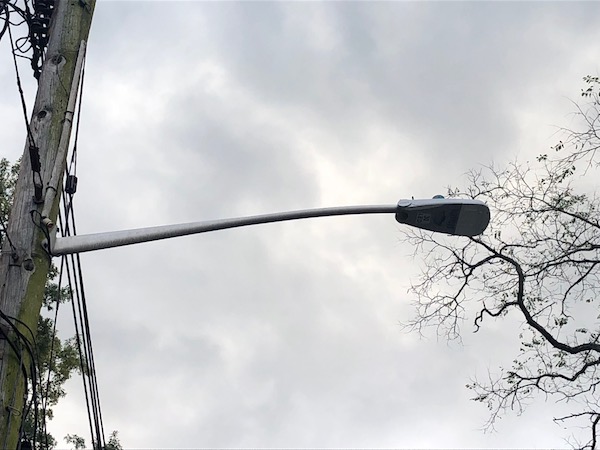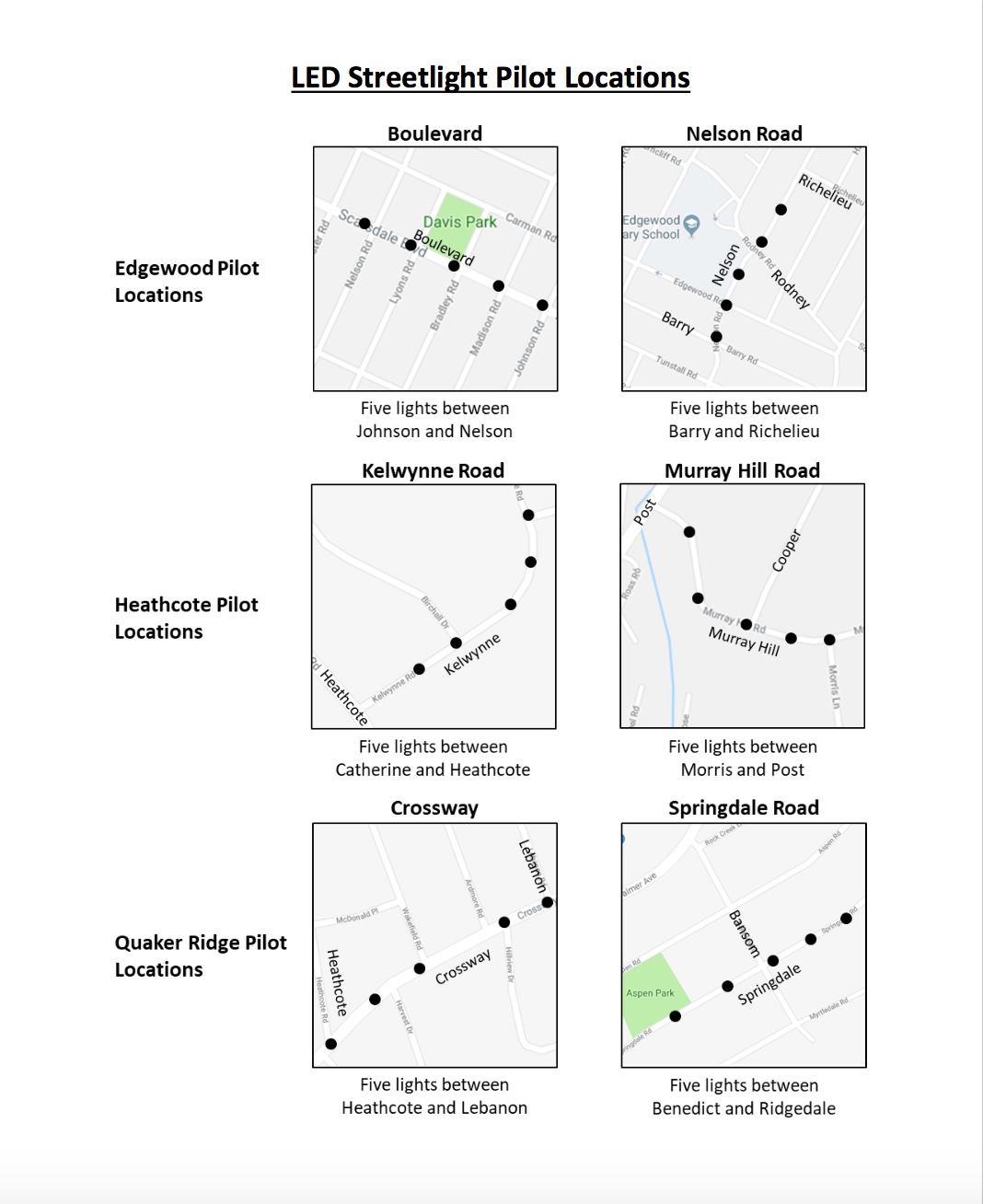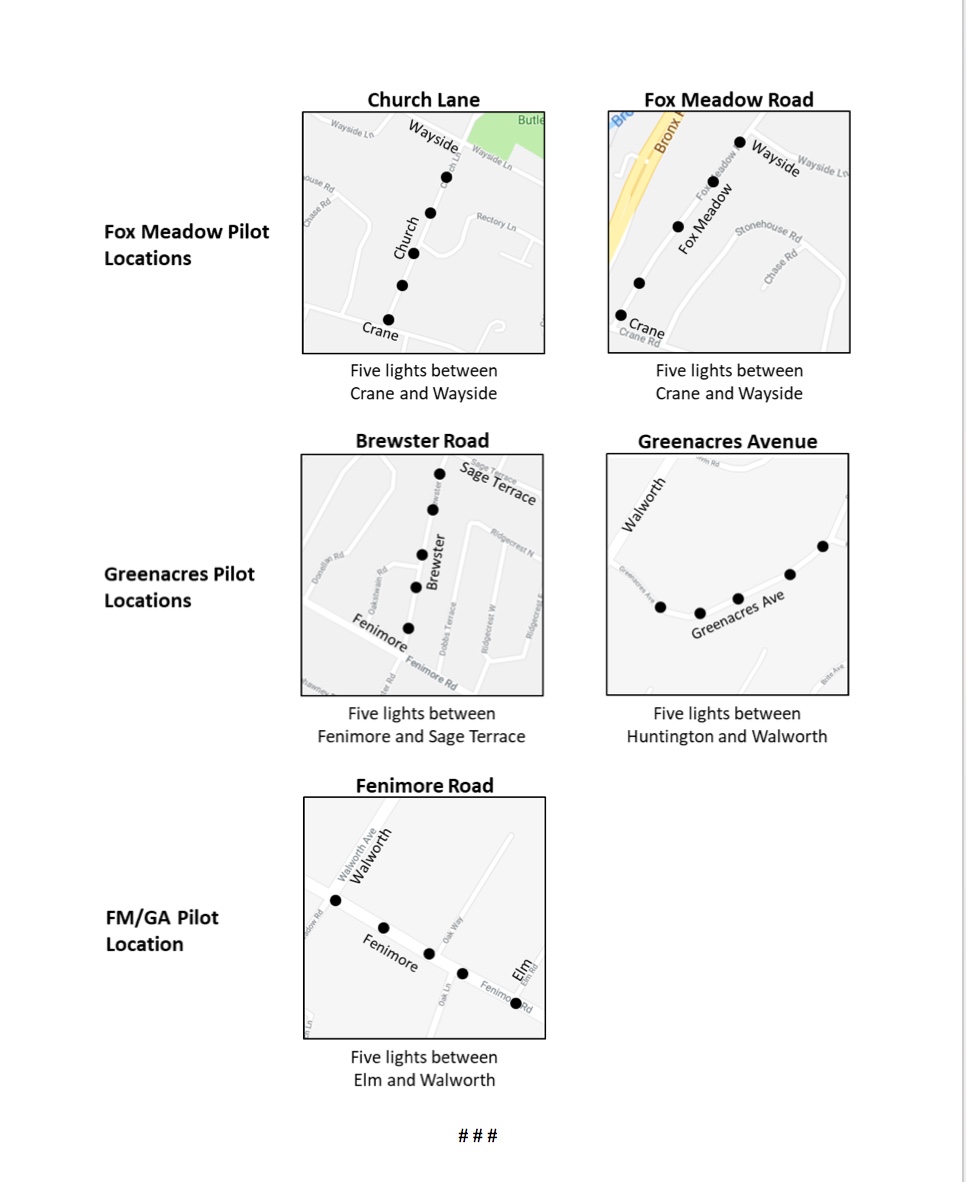Phase II of LED Streetlight Pilot is Underway
- Details
- Written by: Joanne Wallenstein
- Hits: 3518
 Phase II of the Village’s successful LED Streetlight Conversion Project, a pilot involving residential roadway lighting, is launching today. LED streetlights for the Phase II pilot have been installed at 11 locations throughout the village, as depicted on the maps available online and provided on pages two and three of this press release.
Phase II of the Village’s successful LED Streetlight Conversion Project, a pilot involving residential roadway lighting, is launching today. LED streetlights for the Phase II pilot have been installed at 11 locations throughout the village, as depicted on the maps available online and provided on pages two and three of this press release.
The Village wants to hear what Scarsdale residents think about the new LED streetlights!
During the one-month pilot period, they ask that residents visit locations depicted on the maps and provide feedback by emailing LED@scarsdale.com or by dropping-off written comments at Village Hall in the LED comment box located at the first floor service counter. Subject to the results of this pilot, all remaining standard streetlight fixtures will be upgraded to LED, so now is the time to express your opinion.
The first phase of the LED Streetlight Conversion Project, streetlights on High Traffic Roads and locations with Town and Country fixtures, was completed in May 2018. Approximately 300 fixtures were converted to LEDs and the fixtures have since performed well. The Phase II LED fixtures differ from the High Traffic Road fixtures in that they are intended for residential roads.
The Ad Hoc Committee on LED Lights, formed by the Village Board in April 2015 and tasked with conducting research and making recommendations to improve street lighting, reduce costs for electricity and fixture maintenance, and conserve energy, has been highly successful in their efforts. Additional information, including Committee updates and reports, is available from the Scarsdale LED Streetlight Project webpage, or by emailing LED@scarsdale.com.

Pulitzer Prize-Winning Journalist and Author Linda Greenhouse to Speak at LWVS Food for Thought Luncheon on November 1st
- Details
- Written by: Joanne Wallenstein
- Hits: 3347
 Linda Greenhouse, the Joseph Goldstein Lecturer in Law at Yale Law School and former Supreme Court correspondent for the New York Times, will be the League’s Keynote Speaker at its annual Food for Thought Luncheon on Thursday November 1 at 11:45 am at Scarsdale Golf Club. Ms. Greenhouse will speak about the Supreme Court, upcoming cases to be heard by the Court and the recent nomination process of Brett Kavanaugh.
Linda Greenhouse, the Joseph Goldstein Lecturer in Law at Yale Law School and former Supreme Court correspondent for the New York Times, will be the League’s Keynote Speaker at its annual Food for Thought Luncheon on Thursday November 1 at 11:45 am at Scarsdale Golf Club. Ms. Greenhouse will speak about the Supreme Court, upcoming cases to be heard by the Court and the recent nomination process of Brett Kavanaugh.
Linda Greenhouse is the Joseph Goldstein Lecturer in Law at Yale Law School. She assumed that position in 2009 following a 40-year career at the New York Times. From 1978 until 2008, she was the newspaper’s Supreme Court correspondent and currently writes a biweekly opinion column on law as a contributing columnist.
Ms. Greenhouse received several major journalism awards while covering the Supreme Court, including the Pulitzer Prize (1998) and the Goldsmith Career Award for Excellence in Journalism from Harvard University’s Kennedy School (2004). In 2002, the American Political Science Association gave her its Carey McWilliams Award for “a major journalistic contribution to our understanding of politics.”
She is a former member of the Harvard University Board of Overseers and serves on the governing boards of the American Academy of Arts and Sciences, Phi Beta Kappa, and the American Constitution Society. She is one of two non-lawyer members of the American Law Institute, which in 2005 awarded her its Henry J. Friendly Medal. In April 2017, she became the first female president of the American Philosophical Society, the nation’s oldest learned society, founded by Benjamin Franklin in 1743.
Her biography of Justice Harry A. Blackmun, Becoming Justice Blackmun, was published in 2005. Her other books include Before Roe v. Wade: Voices That Shaped the Abortion Debate Before the Supreme Court’s Ruling, co-authored with Reva Siegel; The U.S. Supreme Court: A Very Short Introduction; and The Burger Court and he Rise of the Judicial Right (with Michael J. Graetz). Her most recent book is a memoir entitled Just a Journalist, published in 2017 by Harvard University Press.
For further information and to purchase ticket(s) using a credit card or PayPal, please visit the LWVS website at LINK www.lwvs.org and select Event Ticket.
Board Briefs: Village Gets AAA Rating from Moody's, DeCicco's to Expand and Halloween Window Painting on Sunday 10/21
- Details
- Written by: Laura Halligan
- Hits: 4576
 In addition to discussing flooding concerns in Scarsdale, the Scarsdale Board of Trustees meeting covered a variety of other issues and news. Here are some highlights:
In addition to discussing flooding concerns in Scarsdale, the Scarsdale Board of Trustees meeting covered a variety of other issues and news. Here are some highlights:
Mayor’s Comments
With fall upon us, Mayor Dan Hochvert reminded residents that, during lawn clean ups, leaves should not be placed in village streets. These leaf piles are safety hazards for both motorists and pedestrians, and often clog sewer drains. Residents who do not comply will receive a warning for the first violation and a summons for the second. He urged residents to report any piles of leaves in streets to the Scarsdale Highway Department during business hours (722-1150) and said, “We are serious about keeping people safe.”
Hochvert also mentioned that Metro North is proposing a renovation project at the Scarsdale train station in 2019. The village will schedule a public meeting for residents to review and comment on the proposed work.
He closed by sharing information on “Jackie’s Walk 4 HD,” a fundraiser for Huntington’s Disease research, scheduled for Sunday, October 14, from 9:00 am to 12:00 pm, at Glen Island Park.
Village Manager’s Report
Pappalardo reported that Moody’s Investor Services has reviewed Scarsdale’s financial position in conjunction with its upcoming bond issue, and has reaffirmed its AAA rating. As many readers know, the village will be issuing an $11.4 million bond to fund its portion of library renovation project ($9.9 million) and upgrades to the Ardsley Road storage tank ($1.4 million). He then quoted Moody’s report, which stated, “The village’s financial position is strong and stable, with ample reserves relative to sector medians… The village’s strong, wealthy tax base, conservative budgeting practices and ample reserves will continue to support the overall credit profile.”
Trustee Reports
Village Trustee Lena Crandall reported that Scarsdale-Edgemont Family Counseling Service was recently re-accredited by the Council on Accreditation, an international, human service accrediting association that promotes the well being of individuals, families and communities.
She then mentioned the recent Drug and Alcohol Task Force presentation on “Youth Driving While Under the Influence of Marijuana,” which will be broadcast via Scarsdale Public Television shortly. “This is information all residents need to know, regardless of your age.”
Crandall also noted that the annual Scarsdale Halloween window painting event will be held on Sunday, October 21; residents may register online via scarsdale.com through Tuesday, October 16. The village also will host its Halloween costume parade by Chase Park on Wednesday, October 31; line up begins at 3:45 pm and the parade starts at 4:00 pm.
Trustee Carl Finger stated that the Law Committee approved a proposed amendment to the village code with regard to streets, sidewalks and public places. Specifically, a new provision has been added, which gives the village engineer three days to grant or deny a permit to obstruct any public place (e.g., signage). “We’ve had some comments, generally, about the use of the right-of-way… the aesthetics associated with signage and other obstructions in the right-of-way. We’re not addressing those issues in this resolution. It was called to our attention that it would be helpful… to include a… timeframe for when the village engineer would approve some type of obstruction.” Finger said that a public hearing would be held and invited residents to attend and share their thoughts about safety, aesthetics and other concerns about the use of the village right-of-way.
Trustee Jane Veron discussed the Scarsdale Municipal Services Committee meeting held earlier in the evening, which focused on the condition of village roadways. “We, as a board, take the condition of the roads very seriously. We understand that residents have identified roads as a top priority and we are vigilant about understanding what it takes to optimize our roadway conditions.” During the meeting, which has been taped, village staff reviewed the village re-pavement program, general road maintenance procedures and related expenditures. “We encourage residents to educate themselves… it will be an important budget conversation… bringing the roads to a place where we address most of the ‘fair’ and the ‘poor’ roads will impact the budget and we’d like to hear from the public on… how they wish to spend tax dollars.”
Veron then stated that the village will hold a Land Use Committee meeting later in October to review priority land use issues, such as clear cutting. In addition, in talking about activities in downtown Scarsdale, she reported that DeCicco Family Market will be expanding into the space previously occupied by the Chase Private Bank on East Parkway. The retailer plans to offer more produce and prepared foods, and will provide patrons with a dining space. The entire supermarket will be updated and the renovation work already is in progress.
Trustee Matt Callaghan reminded residents about the upcoming Fire Fair to be held on Saturday, October 20 at Crossway Field. The daylong event will feature a variety of family-friendly activities’ 1,300 people attended last year. He also mentioned that as we soon will be turning our clocks back for one hour, it is time to change batteries in our smoke detectors. “To go along with that, regarding your (battery operated) fire detectors, change those out every five years because the radiation piece that makes the sound wears out. The same (goes for) fire extinguishers; get rid of them every five years… A number of our residents have hard-wired systems; those devices should be changed every 10 years… the exception is if you test them every year with (the help of) a qualified service, which is quite expensive.”
Laura Halligan is a local writer, editor and marketing consultant. She is principal of Pinch Hit Prose and provides communications services to entrepreneurs, small businesses and nonprofits.
SAS Hosts 80th Anniversary Academy
- Details
- Written by: Joanne Wallenstein
- Hits: 3248
 Scarsdale Adult School, founded in 1938, is hosting an 80th Anniversary Academy on Sunday, Oct. 14, 2018 from 2 to 5 p.m. at Hitchcock Presbyterian Church. The keynote (2-3 p.m.) features Laurie Santos, Psychology Professor at Yale University, who will provide SAS students a mini version of her undergraduate course entitled “Psychology and the Good Life,” the most popular class ever offered at Yale. Her lecture will explore scientifically validated strategies for leading a more satisfying life. Attendees will learn the habits and behavioral changes to increase their overall happiness and well-being.
Scarsdale Adult School, founded in 1938, is hosting an 80th Anniversary Academy on Sunday, Oct. 14, 2018 from 2 to 5 p.m. at Hitchcock Presbyterian Church. The keynote (2-3 p.m.) features Laurie Santos, Psychology Professor at Yale University, who will provide SAS students a mini version of her undergraduate course entitled “Psychology and the Good Life,” the most popular class ever offered at Yale. Her lecture will explore scientifically validated strategies for leading a more satisfying life. Attendees will learn the habits and behavioral changes to increase their overall happiness and well-being.
Those who register for the full afternoon may choose between two different one-hour classes offered by veteran SAS instructors Alfred Hunt and Page Knox. Hunt’s Around the World in 80 Days with Mark Twain delves beyond Twain’s humor to explore his prescient opinions and reactions to global warfare, racism, and imperialism. Page Knox’s Alfred Stieglitz and His Circle examines Stieglitz’s vital role in establishing a wholly American brand of modernism and in expanding the public’s acceptance of photography as an art form.
The afternoon concludes with an annotated concert of Benny Goodman’s 1938 hits with contemporary arrangements, performed by SAS instructor Daniel Blake and his jazz ensemble, the Digging. Delicious appetizers will be prepared by SAS’s newest cooking instructor, Jensina Olson, caterer in residence at the church (4-5 p.m.).
Registration is open to all adults, regardless of residency. Students may sign up for the entire afternoon ($80) or just the keynote ($25) and/or jazz concert and closing reception ($25). For more information or to register, visit www.ScarsdaleAdultSchool.org.
Halloween Window Painting and Costume Parade
- Details
- Written by: Joanne Wallenstein
- Hits: 5857
 The Scarsdale Parks and Recreation Department will be holding their 67th Annual Halloween Window Painting Program on Sunday, October 21st from 9:00am–4:00pm. All adults and children who reside in or attend public or private schools in Scarsdale in are eligible to participate in this event.
The Scarsdale Parks and Recreation Department will be holding their 67th Annual Halloween Window Painting Program on Sunday, October 21st from 9:00am–4:00pm. All adults and children who reside in or attend public or private schools in Scarsdale in are eligible to participate in this event.
The Halloween Window Painting Contest is open to children in Grades 3-10. Judges will determine a winner from each age group and one overall winner. Prizes will be awarded at a special awards ceremony in November.
The Family Window Painting program is an opportunity for young children and their parents, teens above 10th Grade, or adults who want to show off their artistic ability to participate in this annual village tradition. There are no age limits in this group, and any Scarsdale residing individual, team, or family of up to five members may decorate a window. Family Window Painting is NOT a contest. Participation ribbons will be awarded to each entry.
Deadline to register for the Halloween Window Painting programs is Tuesday, October 16th. As windows are limited, registration is on a first-come, first-served basis. Please register online at http://www.scarsdale.com/recreation
For questions, call the Recreation Department at 722-1160
On Wednesday, October 31st (Halloween,) there will be a Costume Parade held in the Village streets by Chase Park. The parade line up begins at 3:45 pm in front of Chase Park. The parade will start at 4:00 pm. Special entertainment and refreshments provided by Lange’s Deli will be served after the parade. All Pre-K and Elementary School children are welcome to participate in the costume parade. Please note that the parade this year WILL NOT take place on the day of window painting as in the past.










